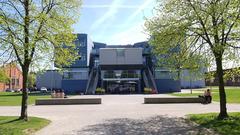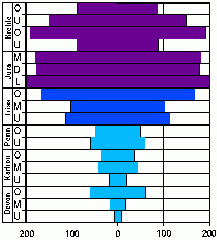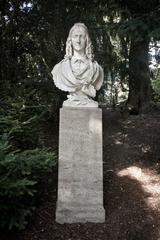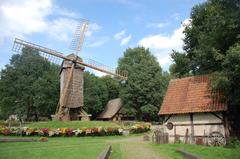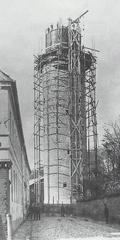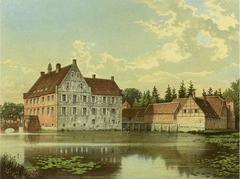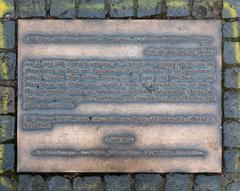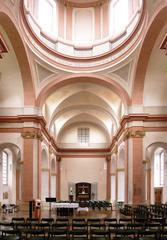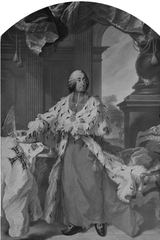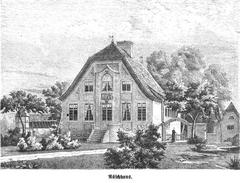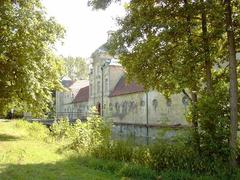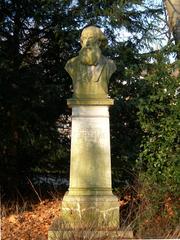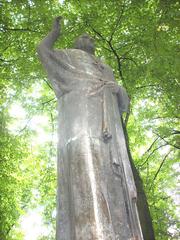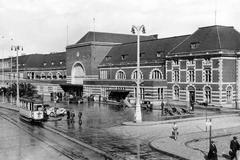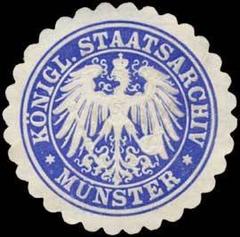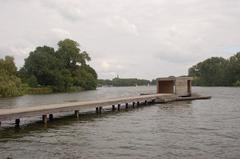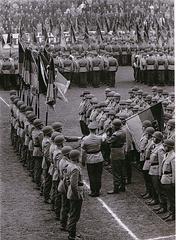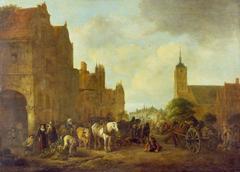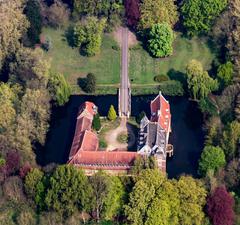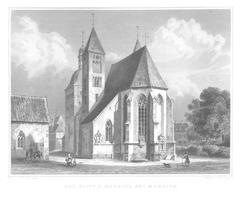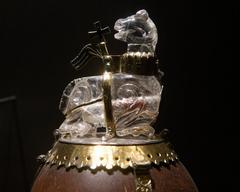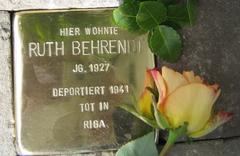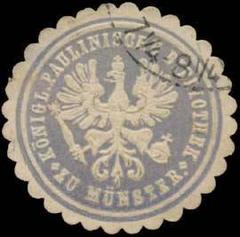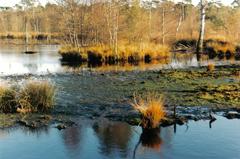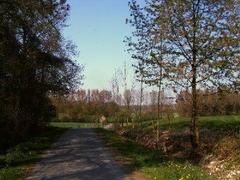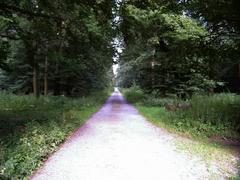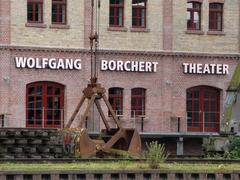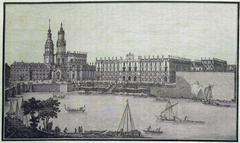Haus Brock Visiting Hours, Tickets, and Tourist Guide – Münster, Germany
Date: 03/07/2025
Introduction
Haus Brock, located in Münster-Roxel, North Rhine-Westphalia, is a quintessential example of Westphalian Renaissance architecture and an enduring symbol of the Münsterland region’s feudal and cultural heritage. First documented in 1266, this moated manor (Wasserburg) embodies centuries of aristocratic tradition, social evolution, and architectural innovation. Although a private agricultural estate, Haus Brock opens its gates to the public for select events, providing rare glimpses into its storied past, stunning architecture, and the lives of Münsterland’s hereditary landowners (Stadt Münster, Denkmalschutz NRW, Deutsche Stiftung Denkmalschutz).
This in-depth guide details Haus Brock’s historical significance, architectural features, practical visiting information—including hours, admission, and accessibility—as well as tips for exploring nearby Münster attractions. Whether you’re a history buff, an architecture enthusiast, or a traveler seeking authentic cultural experiences, Haus Brock is a compelling destination that enriches any Münsterland itinerary (Komoot, WN.de, westfalen-adelssitze.de, Münsterland Tourism).
Table of Contents
- Introduction
- Historical Overview
- Architectural & Cultural Highlights
- Visitor Information
- Special Events & Guided Tours
- Photography and Outdoor Activities
- Nearby Münster Attractions
- FAQ
- Conclusion & Final Tips
- References
Historical Overview
Early History
Haus Brock stands on the banks of the Werse River and was first mentioned in 1266 as a fortified noble residence. Founded by the von Brock family, it served as a defensive manor surrounded by moats typical of Westphalian estates, acting as both an administrative and agricultural hub in Münsterland (Stadt Münster).
Architectural Evolution
Significant expansions and architectural refinements occurred over centuries:
- Late 15th–16th Centuries: The estate was rebuilt in the Renaissance style, with brickwork, stepped gables, and decorative elements.
- 1623: Construction of the iconic Torhaus (gatehouse), a hallmark of Westphalian Renaissance architecture, combining defensive features and artistic flourishes (Komoot).
- Baroque Period: Ornamental gardens and courtyards were added.
- 19th Century: Neo-Gothic elements appeared after damage in the Napoleonic era (Denkmalschutz NRW).
Significance & Notable Events
As a seat of local power, Haus Brock played pivotal roles during the Thirty Years’ War and Napoleonic occupation, hosting regional leaders and serving as a defensive refuge. The estate was associated with influential families like the von Brocks and von Kettelers, and its preservation owes much to community efforts, especially during WWII (Kulturlandschaft Westfalen-Lippe).
Architectural & Cultural Highlights
- Torhaus (1623): A two-story red brick gatehouse with stepped gables, natural stone-framed gateway, and alliance coat of arms of the Stevening and Bischopinck families. The Torhaus’s robust walls, construction joints, and oriel traces narrate its layered history (Komoot).
- Moat System: Originally two islands surrounded by moats (Gräften); today, remnants remain, adding to the estate’s atmospheric charm.
- Interiors: During special tours, visitors can see preserved early modern features, including the gatekeeper’s quarters, working kitchen, servant rooms, and attic storage.
- Heraldic and Defensive Features: Architectural flourishes and defensive design elements reflect the estate’s dual role as a residence and fortress (westfalen-adelssitze.de).
Visitor Information
Visiting Hours & Tickets
- Regular Access: Haus Brock is a private, working farm and is generally closed to the public. The estate can be admired from public paths and cycling routes year-round.
- Open Monument Day: Each September, during the “Tag des offenen Denkmals,” the estate opens for guided tours. Admission is typically free for this event, but advance registration is often required due to limited capacity (Stadt Münster Denkmalpflege).
- Special Tours: Occasional private guided tours may be booked in advance for a nominal fee, subject to availability. Tickets for these can be reserved via the official Münster tourism website.
Accessibility & Travel Tips
- Getting There: Located at Brock 27, 48161 Münster-Roxel. Reachable by car, bicycle (on Münsterland’s scenic routes), or public transport (bus lines to Roxel, then a short walk).
- Parking: Limited near the estate; public parking in Münster with transit connections is recommended.
- Accessibility: The grounds are wheelchair accessible, though some interiors may have limited access. Contact the site in advance for accommodations.
- Facilities: No restrooms or visitor center on-site; amenities are available in nearby Roxel or Münster city center.
- Travel Tip: Wear sturdy footwear and bring water/snacks for rural visits. Respect private property boundaries at all times.
Special Events & Guided Tours
- Open Monument Day: The main opportunity for interior access and guided tours, featuring expert commentary by estate owners and heritage professionals (wn.de).
- Restoration Projects: Access may be restricted during renovation work, such as the recent €80,000 Torhaus restoration funded by the Deutsche Stiftung Denkmalschutz (Deutsche Stiftung Denkmalschutz).
- Private Tours/Events: Occasionally organized by appointment; check with the Heitplatz family or local tourism office.
Photography and Outdoor Activities
- Photography: The Torhaus, moat, and rural landscape offer excellent subjects for photographers. Early morning or golden hour lighting is ideal; use a zoom lens for detailed shots from public paths (freizeitmonster.de).
- Cycling & Walking: Haus Brock is a popular stop on cycling routes through Münsterland’s countryside; public paths allow for relaxed exploration and scenic views.
Nearby Münster Attractions
- Roxel Village: Local bakeries, restaurants, and amenities.
- Münster City Center: Prinzipalmarkt, St. Paulus Cathedral, Westphalian Museum of Art, and more (europeforvisitors.com).
- Other Manor Houses & Castles: The region boasts a network of historic estates, including Burg Hülshoff and Schloss Nordkirchen (nrw-tourist.de).
Frequently Asked Questions (FAQ)
Q: When is Haus Brock open to the public?
A: Primarily during “Tag des offenen Denkmals” in September and for special pre-arranged tours.
Q: Are tickets required?
A: Admission is free on Open Monument Day; private tours may require a nominal fee and advance booking.
Q: Can I access the interiors?
A: Interior access is limited to guided tours during special events.
Q: Is Haus Brock wheelchair accessible?
A: The grounds are accessible; some interiors may be challenging. Contact ahead for details.
Q: Are there facilities on-site?
A: No; use amenities in Roxel or Münster city center.
Q: Can I take photographs?
A: Yes, from public paths. Commercial or drone photography requires permission.
Conclusion & Final Tips
Haus Brock is a unique testament to Münsterland’s aristocratic, architectural, and rural legacy. Although public access is limited, its annual Open Monument Day and occasional tours offer a rare opportunity to explore its Renaissance Torhaus, moats, and historic grounds. Pair your visit with other Münster attractions for a complete cultural experience, and refer to official tourism and heritage websites for up-to-date information on events and restoration projects.
For an enhanced visit, download the Audiala app for guided audio tours and follow local heritage organizations for the latest news and event announcements.
References and Official Links
- Stadt Münster
- Denkmalschutz NRW
- Deutsche Stiftung Denkmalschutz
- Komoot: Haus Brock Highlight
- WN.de: Haus Brock Restoration
- Westfalen-Adelssitze: Haus Brock
- Münsterland Tourism
- Stadt Münster Denkmalpflege
- Freizeitmonster: Haus Brock
- Europe for Visitors: Münster
- NRW-Tourist: Münster Sights
